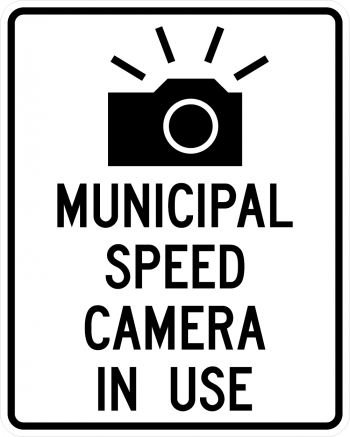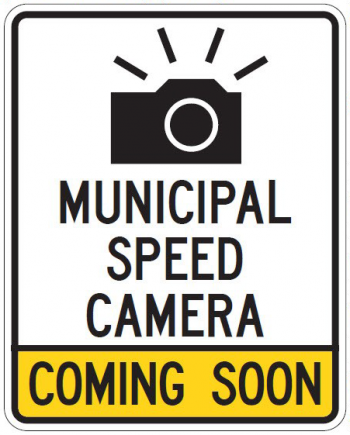
Automated Speed Enforcement (ASE) is an automated system that uses a camera and a speed measurement device to detect and capture images of vehicles travelling in excess of the posted speed limit. It is designed to work in tandem with other methods and strategies, including engineering measures, education initiatives and traditional police enforcement. ASE is focused on altering driver behaviour to decrease speeding and increase safety.
If a vehicle is detected by the ASE system travelling in excess of the posted speed limit, the registered owner of the vehicle will receive a violation notice regardless of who was driving. The total payable amount is determined by Ontario Regulation 355/22 under the Highway Traffic Act and includes a Set Fine, victim fund component and a provincial licence plate access fee. No demerit points will be issued by the Ministry of Transportation and no one’s driving record will be impacted.
Images are reviewed by Provincial Offence Officers and then violation notices are issued to the owner of the vehicle – regardless of who was driving. Upon conviction, a fine is issued under the administrative penalty system, which does not impact driving records or demerit points.
If you have received a automated speed enforcement penalty in the mail, you can find out more information about paying or disputing your penalty.

Locations are selected through a data-driven approach that considers vehicle speed and collision data. ASE systems are placed in Community Safety Zones.
Signs will be posted advising motorists when they are in a Community Safety Zone with an ASE system. Motorists should always obey the speed limit and always drive at a speed that will let them stop safely. This means driving below the posted speed limit in bad weather, in heavy traffic or in Community Safety Zones.
There are 75 ASE systems installed on local, collector and arterial roads in Community Safety Zones across the City with plans to install an additional 75 ASE systems in early 2025.

The ASE systems are mobile or permanent (pole-mounted). The mobile ASE systems rotate regularly which provides an opportunity to address a greater number of areas with safety concerns and provide a wider-ranging deterrent effect. “Coming soon” warning signs will be posted at least 90 days before violations are issued at any new ASE location. Warning letters will not be issued
In selecting ASE sites, a two-staged process is used that was developed based on best practices and provincial guidelines.
Stage 1: First, an initial screening of all Community Safety Zones is completed and the Community Safety Zones are prioritized based on the following data:
Once sites are assessed, operational considerations may result in minor adjustments to site prioritizations.
To submit a request for ASE, please fill in the online form.
The City launched a multilingual public education campaign to remind residents of the presence of ASE systems and the dangers of speeding.
Higher driving speeds contribute to a higher risk of serious injuries and fatalities:
From January 20, 2020 to March 31, 2020, the City issued over 25,000 warning letters to the registered owners of speeding vehicles. This was part of the City’s education campaign to inform residents about the new program and the implications of speeding. No tickets were issued during this period.
The Automated Speed Enforcement (ASE) pilot occurred between September and December of 2018.
During this four-month pilot program, ASE units were used to collect data to better understand the processing and administrative requirements of the enforcement program. Data was collected from school zones located on local, collector, and arterial roads at a total of 8 locations, with each location active for 1 month and included the collection of speed and volume data, 24 hours a day, 7 days a week.
The Automated Speed Enforcement pilot project did not involve the issuance of tickets or charges to vehicle owners as the regulations necessary from the Province of Ontario have not yet been enacted.
The following table provides a summary of the locations where the cameras were deployed and the data that was collected at each of the locations.
| Location (speed limit) | Average Weekly Vehicles detected above the speed limit | Average Weekly Vehicles detected more than 10km/h above the speed limit | Average Weekly Volume | Max Detected Speed (km/h) |
|---|---|---|---|---|
| Gateway Blvd
(40km/h) |
10,347 | 1,010 | 52,911 | 86.9 |
| Don Mills Rd
(60km/h) |
5,743 | 1,058 | 85,488 | 137.9 |
| Queen St
(40km/h) |
23,748 | 5,587 | 52,150 | 127.4 |
| Renforth Ave
(40km/h) |
25,511 | 7,370 | 37,091 | 202.3 |
| Wilson Ave
(50km/h) |
52,151 | 16,937 | 83,867 | 156.4 |
| Dufferin St
(50km/h) |
14,139 | 2,192 | 63,498 | 124.4 |
| Rockcliffe Blvd
(30km/h) |
49,608 | 32,571 | 56,230 | 102.8 |
| Avenue Rd
(40km/h) |
60,170 | 22,013 | 103,180 | 109.8 |
Evaluation data from the City of Toronto’s Automated Speed Enforcement (ASE) program highlight how speed cameras have been effective in significantly reducing the number of people speeding and overall vehicle speeds, pointing to increased compliance and improved driver behaviour.
An evaluation study conducted by researchers from The Hospital for Sick Children (SickKids) in collaboration with the Toronto Metropolitan University (TMU) analyzed speed and collision data from January 2020 to December 2022 at 204 locations that had an ASE device. Although data collection was affected by the pandemic, substantial data was collected during periods without stay-at-home orders or school closures.
The study shows that the proportion of people speeding in 30, 40 and 50 km/h speed limit zones dropped from approximately 60 to 43, 51 to 30 and 58 to 36 per cent respectively when the devices were operational. This represents an overall 45 per cent reduction in the proportion of people speeding in areas with an ASE device.
The data also show the introduction of ASE devices reduced the operating speed of vehicles or the speed at which most vehicles travel in free-flowing conditions, helping to mitigate the potential risks associated with high-speed traffic. Vehicle operating speeds in 30, 40 and 50 km/h speed limit zones dropped from approximately 44 to 37, 50 to 44 and 63 to 60 km/h respectively when the devices were active. This represents an overall decrease of approximately seven km/h in vehicle operating speeds in areas with an ASE device.
The study also found the percentage of drivers exceeding the speed limit decreased at 80 per cent of locations with an ASE device. Excessive speeding – driving over the speed limit by 20 km/h or more – was also reduced by 87 per cent after the placement of an ASE device.
Download the full Automated Speed Enforcement Program Evaluation.